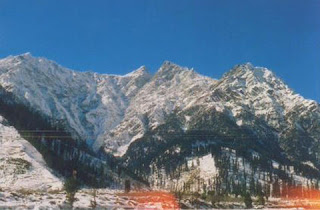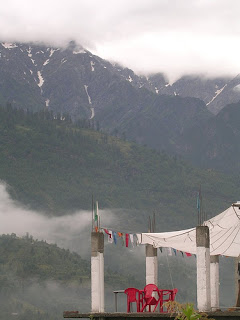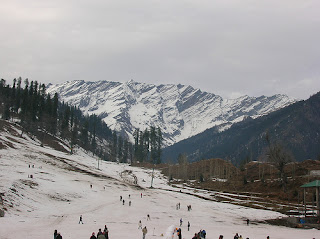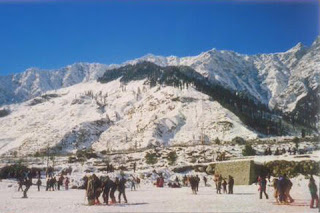Tourism in Manali

Manali literally means the 'Home of Manu'. It is believed that when the world was deluged with rain and all that was land, was covered by water, Manu first stepped off his celestial boat at Manali and it is here that the human race once again came into being. Manali offers marvelous walks through orchards and fairly tale forests of deodar.
At the northern end of the Kullu valley sits the ancient site, but modern town, of Manali. It is a pleasant, if overdeveloped, town with lovely forests and orchards nearby for hiking, and good facilities for visitors. In the 1970s and 1980s, Manali was very much a 'scene'. In summer, the town would attract numerous western hippies and travellers drawn by the high quality marijuana that grows in the area. High season is mid-April to late June, mid-September to early November, mid-September to early November, Christmas and new year.
 Manali on the Beas River valley, is an important hill station in the Himalayan mountains of Himachal Pradesh, India, near the northern end of the Kullu Valley. The Museum of Traditional Himachal Culture, near the Hadimba temple, is worth a visit, which houses artifacts of folk art of the entire Kullu valle.
Manali on the Beas River valley, is an important hill station in the Himalayan mountains of Himachal Pradesh, India, near the northern end of the Kullu Valley. The Museum of Traditional Himachal Culture, near the Hadimba temple, is worth a visit, which houses artifacts of folk art of the entire Kullu valle.Tourism in Manali:
Manali is a popular Himalayan tourist destination and accounts for nearly a quarter of all tourist arrivals in Himachal Pradesh. Surrounded by towering peaks at an arm length, Manali's major asset is its proximity to the snowline. Manali is circled by beautiful glades of deodars and flowering horse chestnuts. It is one of the most popular honeymoon destination and trailhead for numerous treks as well as a great countryside ideal for adventure sport lovers.
 In the Summer Manali is packed with Pahari-speaking Kullus, Lahaulias, Nepali labourers, foreign and Indian tourists. Manali is known for its shiny gompas or Buddhist monasteries. With the highest concentration of Tibetan refugees in the entire Kullu valley, it is famous for its Gadhan Thekchhokling Gompa, built in 1969. The monastery is maintained by donations from the local community and through the sale of hand-woven carpets in the temple workshop.
In the Summer Manali is packed with Pahari-speaking Kullus, Lahaulias, Nepali labourers, foreign and Indian tourists. Manali is known for its shiny gompas or Buddhist monasteries. With the highest concentration of Tibetan refugees in the entire Kullu valley, it is famous for its Gadhan Thekchhokling Gompa, built in 1969. The monastery is maintained by donations from the local community and through the sale of hand-woven carpets in the temple workshop.Places around Manali:
Vashist:

Vashist Hot Water Springs and Temple: Around 3 km from Manali, across the Beas river is Vashist, a small village with natural sulphur springs. Vaishisht, also boasts a pair of old stone temples, opposite each other above the main square. Dedicated to the local patron saint Vashista, the smaller of the two opens on to a partially covered courtyard, and is adorned with elaborate woodcarvings.
Dhungri Temple :
Also known as Hadimba temple, The Dhungri or Hadimba temple is a four storey wooden building in the middle of a lovely forested parkland, known as the Dhungri Van Vihar. This temple is dedicated to the goddess Hadimba, the wife of Bhim. nside the temple is the small back image of the Devi. The imprinted foot prints on a black rock are believed to be the foot prints of the goddess. The temple has intricate carvings of dancers and characters from various Hindu stories.Horns of bulls and other animals decorate the walls. It is a very popular picnic spot for Indian tourists. Every May, there is a major festival at the temple, when sacrifices are carried out in honour of Hadimba.
Solang Nullah :

Some of Himachal Pradesh's best skiing slopes are at Solang Nullah, about 13 kms north-west of Manali. It is a picturesque spot and offers splendid views of glaciers and the snow-capped mountains. Jagatsukh, the former capital of Manali, is also an important spot. February and March are the best months to ski. The area is very pretty in spring and summer and offers great hikes. The winter skiing festival is organised in Solang Valley. Training in skiing is imparted at this place.
Museum of Traditional Himachal Culture :
This small, privately funded museum near the Dhungri temple is worth a quick visit. The curator has spent years collecting folk art and handicrafts from surrounding villages to protect the traditions of the Kullu valley.
Mountaineering Institute :

Located 3 kms. from down-town on the Left Bank of River Beas. This institute also conducts other adventurous sports activities like high altitude trekking, minor mountaineering, rock-climbing, skiing, and high altitude rescue and relief courses. Tourists can visit an interesting showroom of Mountaineering Institute. It is a popular base for trekking and mountaineering in summer and skiing in winter.
Rohtang Pass :

Situated about 50 kms from Manali town at an altitude of 4,111 metres (13,400 ft) on the highway to Keylong, is Rohtang Pass. It is the highest point on the Manali-Keylong road and provides a wide panoramic view of mountains rising far above clouds, which is truly breath taking. Close by is a small lake called Dassaur Lake. Beas Kund, the source of river Beas, is also nearby.
 In winter, the road of Rothang Pass is closed Now regular bus service plies over it from Manali to Keylong in Lahaul district. Here one sees the majesty of the mountains at its height and splendour. At the top of the Pass the air seems to glitter against the snow as you look down over herringboned ridges into the Lahaul Valley.
In winter, the road of Rothang Pass is closed Now regular bus service plies over it from Manali to Keylong in Lahaul district. Here one sees the majesty of the mountains at its height and splendour. At the top of the Pass the air seems to glitter against the snow as you look down over herringboned ridges into the Lahaul Valley.Beas Kund :

The famous Beas Kund, the source of the Beas river, at the Rohtang Pass is easily accessible. The great Vyas Rishi performed 'tapa' here during the Mahabharat Kal. The place is still hallowed by the celestial light. It was because of this that the river got the present name of Beas.
Adventure Sports:

Skiing is a major pastime in Manali. Facilities for skiing are available at Solang Nullah and Rohtang. The Mountaineering Institute at Solang Nullah is a good training institute. Heli skiing is possible at the deep snowfields. The Mountaineering Institute and Allied Sports is about 3 km from the Mall and offers mountaineering and kayaking courses. Kayaking is possible on the Beas River. In the summers, several travel agencies organize paragliding on the slopes of the Solang Nullah. The charges generally include accommodation, food, equipment, and a guide, but not transport.From May to July and, depending on the monsoons, from mid-September to mid-October, some basic rafting is possible on the Beas. The trips generally begin at Pirdi and continue 16 km down to Jhiri.
Labels: hillstations, Himachal
1 Comments:
This is an excellent blog on Manali. We have added a link to this blog from our site
href="http://www.travelpaisa.com">Travel Paisa. Our website provides details on budget holidays and accommodation. You can find link to this blog under blogs section of our site
Post a Comment
Subscribe to Post Comments [Atom]
India Travel and Tours